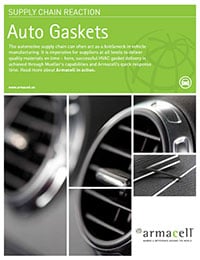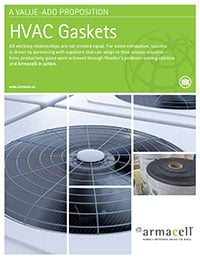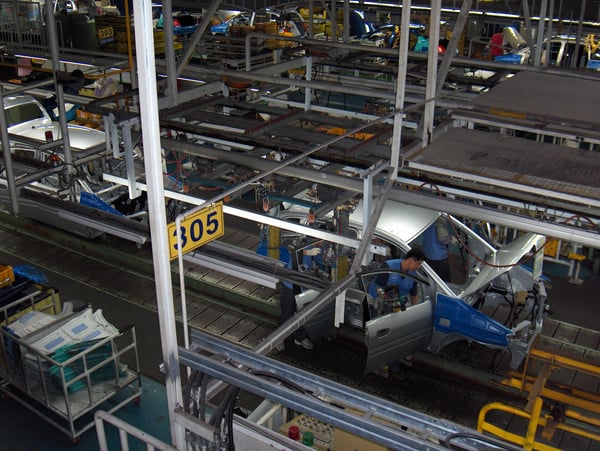
It is crucial for automotive manufacturers to be aware of all potential issues with the vehicles they produce. These issues all start with the materials that make up a product, which makes choosing the right one is key.
Gasketing and sealing applications can make or break a product’s performance and user experience, and there are many factors to consider when choosing the right material for the job.
In this guide, the automotive and transportation experts at Mueller are going to walk you through the different gasketing and sealing applications that you might encounter, as well as the factors you need to consider to make the right decision.
What Are Some Common Gasket and Seal Types?
In the automotive industry, the most common gasketing and sealing applications address sound insulation issues like buzzing, squeaking, and rattling.
These noises can be caused by multiple issues, including pieces of plastic rattling or door components rubbing together.
Many materials address these issues, but they mainly fall into two categories: gap fillers and adhesive backed products.
Gap Fillers
Numerous materials function as gap fillers in automotive applications.
One of the most common is open-cell polyurethane foam, which can act as a dust seal or a gasket between two lightweight components.
Another commonly used material is crushed EPDM foam. This type of foam is very versatile due to its semi-open cell nature, which allows it to compress where it is needed while not compressing in other areas. This allows components to move as needed without sacrificing integrity.
Ultra-high-molecular-weight (UHMW) materials are also frequently used as gap fillers. UHMW films in particular are useful due to their ability to be applied to tight spaces without rubbing away.
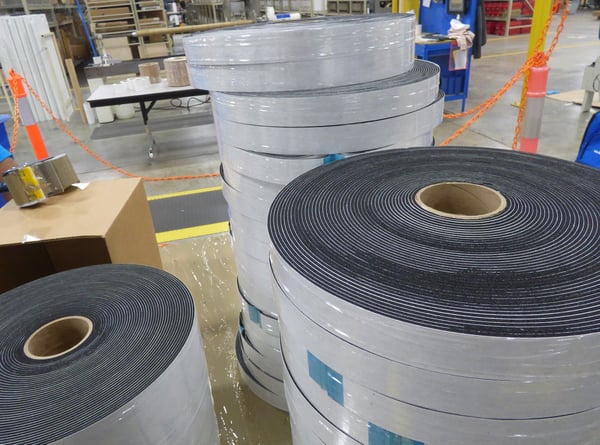
Adhesive Backed Materials
Adhesive backed material excel in spaces that are too small for gap fillers or where components need to be reattached to one another.
Using an adhesive backed material in sealing applications requires you to understand the substrate you’re bonding to, which means you have to know the component’s surface energy. If you use a low surface energy (LSE) adhesive with high surface energy (HSE) material, your solution will not last.
One commonly used adhesive backed material in automotive applications is flocking tape. Flocking tape is best used to reduce squeaking and dampen noise in applications where users might physically see the material (in a sunglasses holder or under a cup holder, for example). This adhesive backed material is an adequate stand-in for materials such as velvet or nylon.
You can also use adhesives with felt or non-woven materials. These materials are great for abrasion resistance and rattling prevention.
There are many more materials than these that are used to solve for common issues in automotive applications, but these should give you an idea of where to start.

What Factors Should I Consider to Make the Right Gasketing or Sealing Decision?
To make the right decision for your application, here are a series of questions you should use to assess the materials you use.
- How much compression is required?
- What is the total gap space?
- Is this an aesthetic solution?
- What surface are you bonding to?
- Are there any industry standards that you need to meet?
- Is this material within your cost range?
Let’s break down each of these questions a little further.
Compression Level
When you examine the level of compression required in your application, you must consider the level of compression set for your material of choice. If you need to compress a material but have it retain its shape afterward, look at open-cell foams. If you need a material with less give, consider non-wovens.
Gap Space
The total gap space of an application goes hand-in-hand with factors like compression. By understanding how much space there is between components, you can determine if they will need to be compressed, which will guide your material selection.
Aesthetics
If the issue you are solving for in your application will be visible to customers and users, you need to use a material that won’t stand out or draw attention. In these instances, using materials like flocking tape or non-wovens is ideal, since they can resemble a vehicle’s upholstery and provide aesthetically pleasing solutions.
Product Surface
As discussed in the previous section, knowing the surface of whatever material you will be adhering to is crucial for the success of the product. You should have a firm understanding of the product’s surface energies.
Industry Standards
It is also important to understand the industry standards your materials need to meet. In all automotive applications, your gasket or seal material must meet Federal Motor Vehicle Safety Standard No. 302 (FMVSS-302), which details burn resistance requirements for materials used in vehicles. You should also consider the use of low volatile organic compound (VOC) materials, which have seen an industry-wide push due to their decreased output of toxic fumes.
Cost
Finally, you need to consider the cost. Finding the right material for the job is essential, but you shouldn’t break the bank in the process. Make sure the material you have selected isn’t a higher level than you need it to be; find the right material for your specific task. If your company is open to it, you can also consider alternative materials, which keep functionality while offering a wider variety of materials and prices.
By acknowledging these factors and using them in your decision-making process, you can ensure that you select the right material for any gasketing or sealing application.
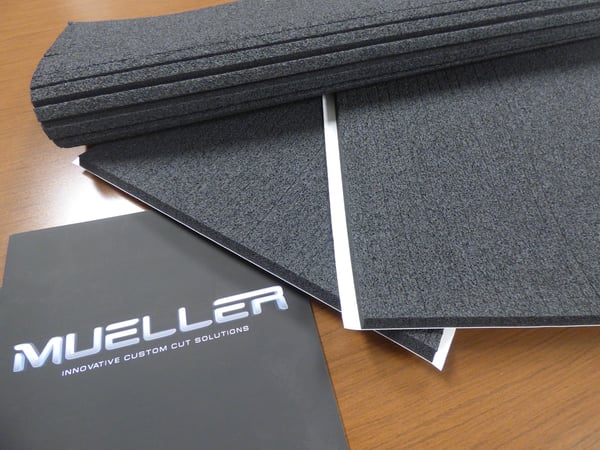
Automotive Gaskets: A Case Study
A few years ago, Mueller was approached to find a solution to a supply chain issue involving gaskets for an automotive manufacturer.
Working with Armacell, a trusted material supplier, Mueller was able to solve the challenges that the manufacturer was facing by developing a new production process, as well as establishing a safety stock program to reduce lead times. The result was a supply chain with decreased lead times, increased product quality, and higher efficiency.
You can download the full case study here!
How Do I Make the Right Gasketing or Sealing Decision?
Choosing the right material for gasketing and sealing applications in the automotive industry is crucial. These materials can affect the performance and user experience of the products you create, meaning proper gaskets and seals can determine the lifespan of a product and its components.
To ensure that you make the right decision, assess what application your materials will be solving for, whether it is filling a gap or adhering different components together to reduce buzzing, squeaking, or rattling.
Then, consider all the different factors that the material you choose must account for. If your material has the proper compression level, fits the gap space, is aesthetically satisfying, is compatible with the product’s surface(s), meets industry standards, and has the best cost, you will know that you’ve found the right choice.
With this guide, you have the information necessary to make the most informed decision in all automotive gasketing and sealing applications. Use these tips to guide your process and create products with reliable performance and positive user experiences.





